The global adhesive tapes market is estimated to be valued at USD 94.90 Bn in 2025 and is expected to reach USD 141.84 Bn by 2032, growing at a compound annual growth rate (CAGR) of 5.9% from 2025 to 2032.
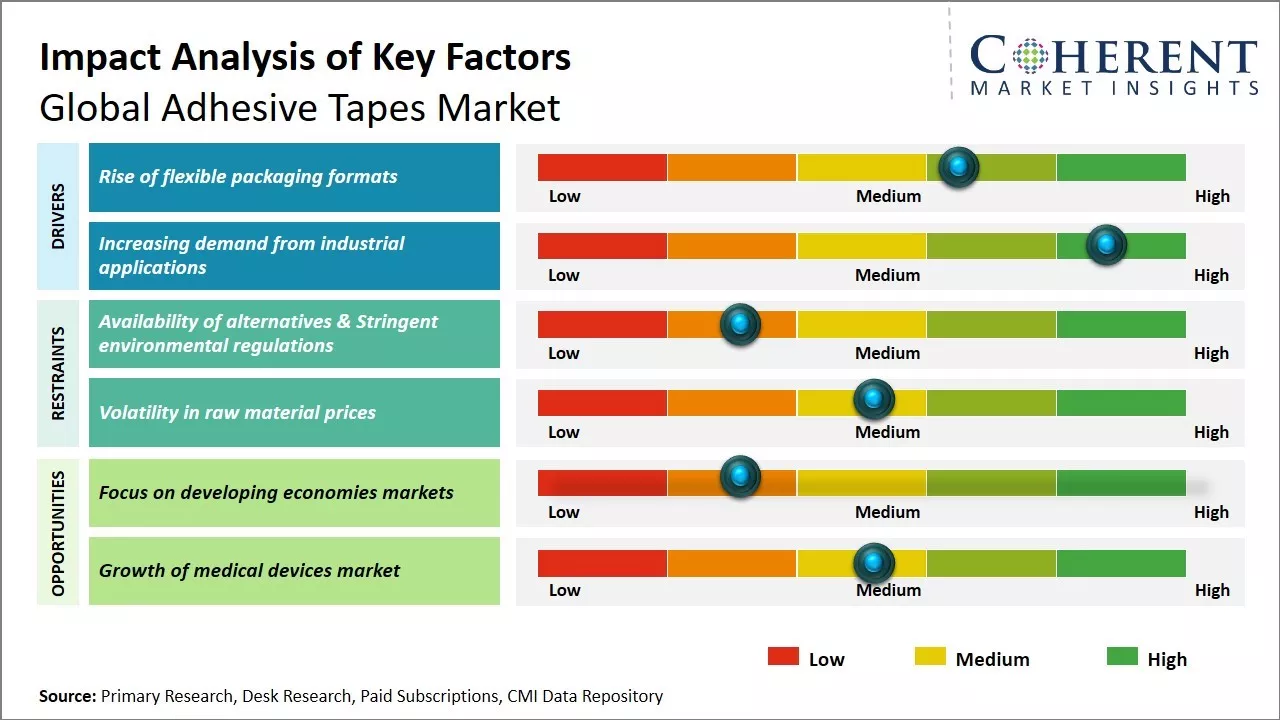
Discover market dynamics shaping the industry: Request sample copy
Adhesive tapes are widely used in packaging, healthcare, electrical & electronics, and other industrial applications. Increased demand from these end-use industries along with growth in the construction and automotive sectors is expected to drive the demand for adhesive tapes globally during the forecast period. The market is witnessing shift towards more specialty tapes which offer superior performance compared to commodity tapes. Specialty tapes such as acrylic, polyvinyl acetate, and silicone-based adhesive tapes have gained popularity owing to their high performance characteristics such as temperature and chemical resistance. These tapes find applications in applications requiring strict adherence to quality standards and operating conditions. Growth in technologies such as electric vehicles and wearable devices will further augment the demand of specialty adhesive tapes going forward.
Rise of flexible packaging formats
The global adhesive tapes market is expected to witness significant growth due to increasing utilization of adhesive tapes in flexible packaging formats. Flexible packaging has emerged as a popular packaging solution due to various advantages such as lightweight, lower material usage, cost effectiveness, durability, and ability to customize packaging as per customer needs. Flexible packaging has wide applications in food and beverages, pharmaceuticals, consumer goods, and several other industries. Adhesive tapes play a pivotal role in the manufacturing of flexible packaging formats. Different types of tapes such as acrylic, rubber, and silicone are used for packaging applications such as closure sealing, laminating, and bonding. Adhesive tapes help provide a strong and durable bond between packaging films and make the packaging leak proof and tamper evident. They ensure packaging formats can withstand transportation and handling stresses without damage. The demand for flexible packaging has increased manifold in recent years, driven by rising urbanization, busy lifestyles, nuclearization of families, and focus towards convenience packaging among consumers. Flexible packaging solutions are revolutionizing the retail sector by offering smaller and customized packaging taylored for individual consumption. This shift towards flexible packaging from rigid alternatives is creating significant opportunities for adhesive tapes manufacturers. Moreover, flexible packaging is highly suitable for packaging fresh and perishable products such as fruits, vegetables, snacks, confectionery, and ready-to-eat meals, which see extensive use of adhesive tapes. With continued growth in food processing and packaging industry, a steady rise is expected in the use of adhesive tapes for sealing and bonding of flexible packaging formats going forward.
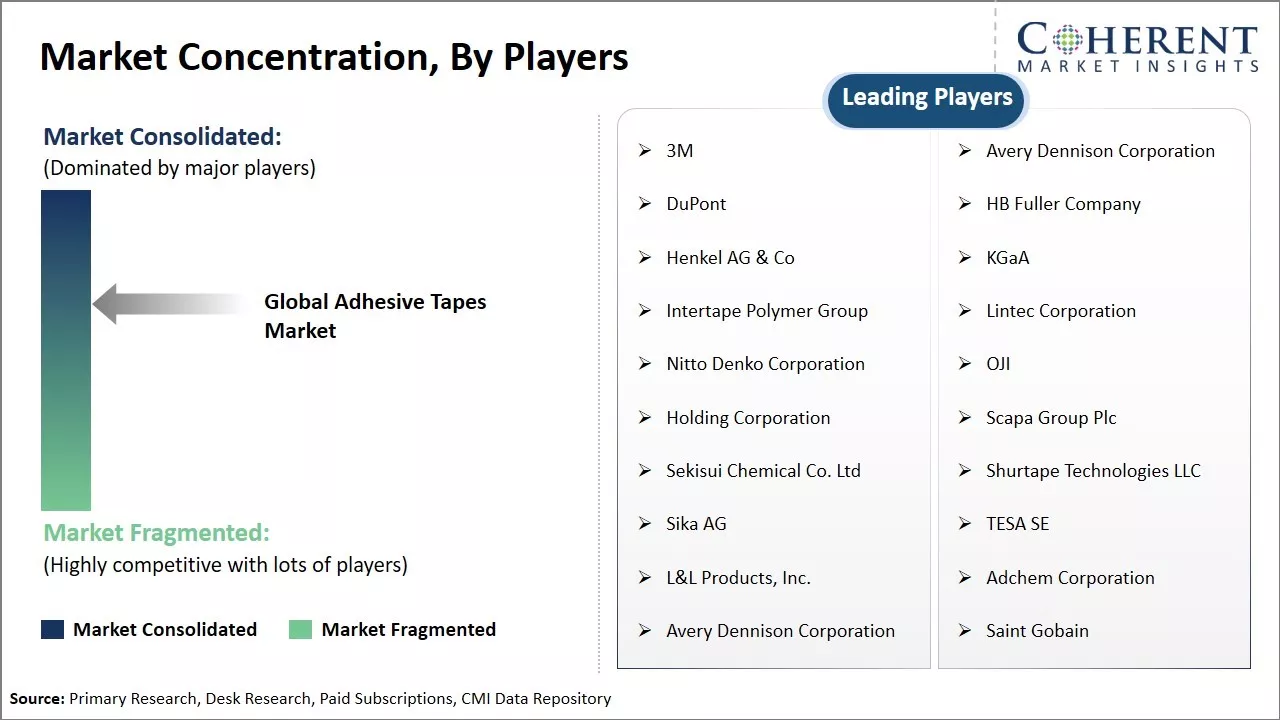
Get actionable strategies to beat competition: Request sample copy
Increasing demand from industrial applicationsRising industrial activity and infrastructure development across major regions have led to significant growth in the demand for adhesive tapes from various industrial applications. Whether it is assembly and production lines in automotive, electronics, or other manufacturing sectors or MRO and repair activities across diverse industrial verticals, adhesive tapes play an indispensable role. Their excellent bonding strength, versatility, and ease of application make them ideal for use in sealing, joining, masking, and mounting purposes. Adhesive tapes help improve productivity and efficiency of industrial processes by allowing for faster assembly and installation of components. Their temporary or permanent bonding capabilities simplify complex manufacturing and fabrication tasks. Important industrial applications driving sales of adhesive tapes include equipment construction and installation, prototyping, repairs, surface protection, packaging, and shipbuilding among others.
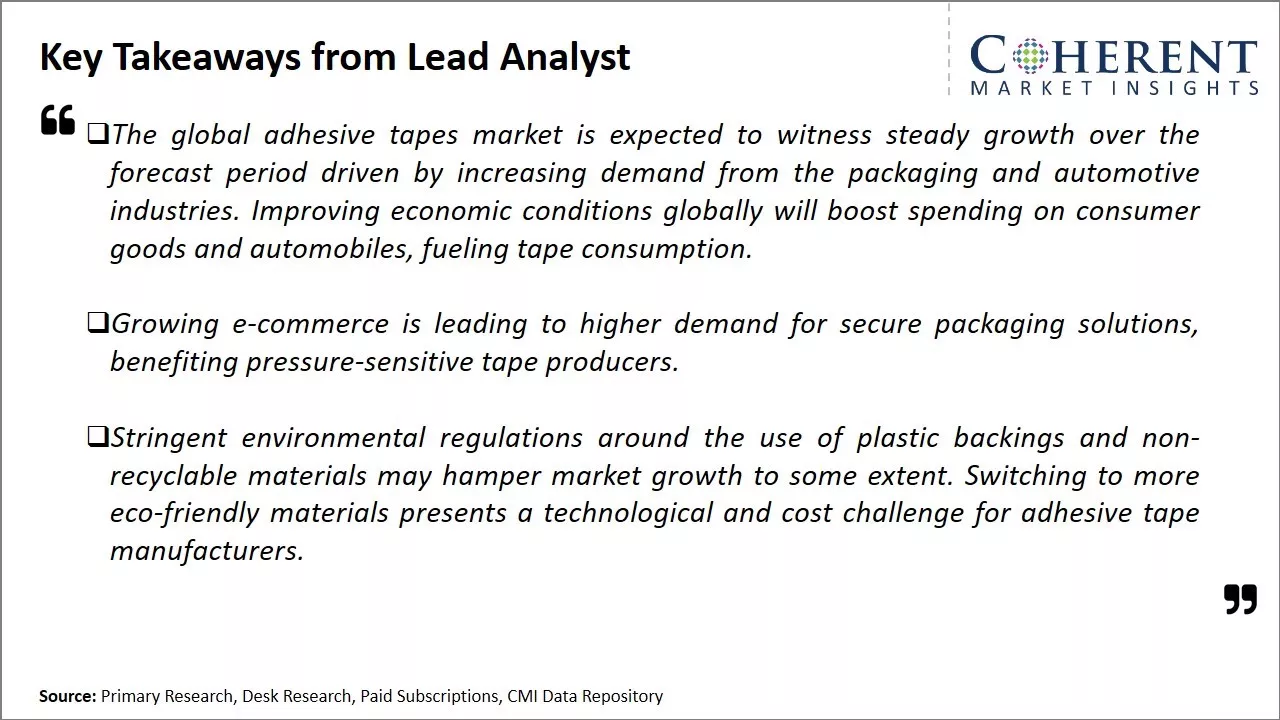
To learn more about this report, Request sample copy
Challenges: Availability of alternatives & stringent environmental regulationsOne of the main challenges faced by the global adhesive tapes market is the availability of alternatives. Many products that traditionally used adhesive tapes can now use newer bonding technologies like liquid adhesives. Stringent environmental regulations around the globe have also increased the demand for eco-friendly adhesive tapes made from renewable or recyclable materials. However, developing such tapes poses technical and cost challenges. Other challenges include volatility in raw material prices and increasing substrate costs. Mature markets like the U.S. and Europe are also saturated, slowing growth in these regions.
Opportunities: Focus on developing economies markets
Focusing on developing economies presents a great opportunity for growth in the global adhesive tapes market. Many developing nations in Asia Pacific , Africa, and Latin America are experiencing rapid industrialization and infrastructure development. This drives significant demand for adhesive tapes across various end-use industries. Construction is one such industry undergoing strong expansion in developing regions. According to data from the World Bank, developing countries accounted for over 80% of the increase in global infrastructure spending between 2000 and 2018. Adhesive tapes are widely used in construction for applications like flooring, roofing, insulation, and glazing. The growth in building and refurbishment projects creates sustained demand. Similarly, transportation networks are strengthening intra-country connectivity. The International Road Federation estimates developing countries will add close to 25 million kilometers of new roads by 2050. Adhesive tapes find applications in rail, automotive, and aircraft manufacturing and maintenance in these multi-modal transport systems.
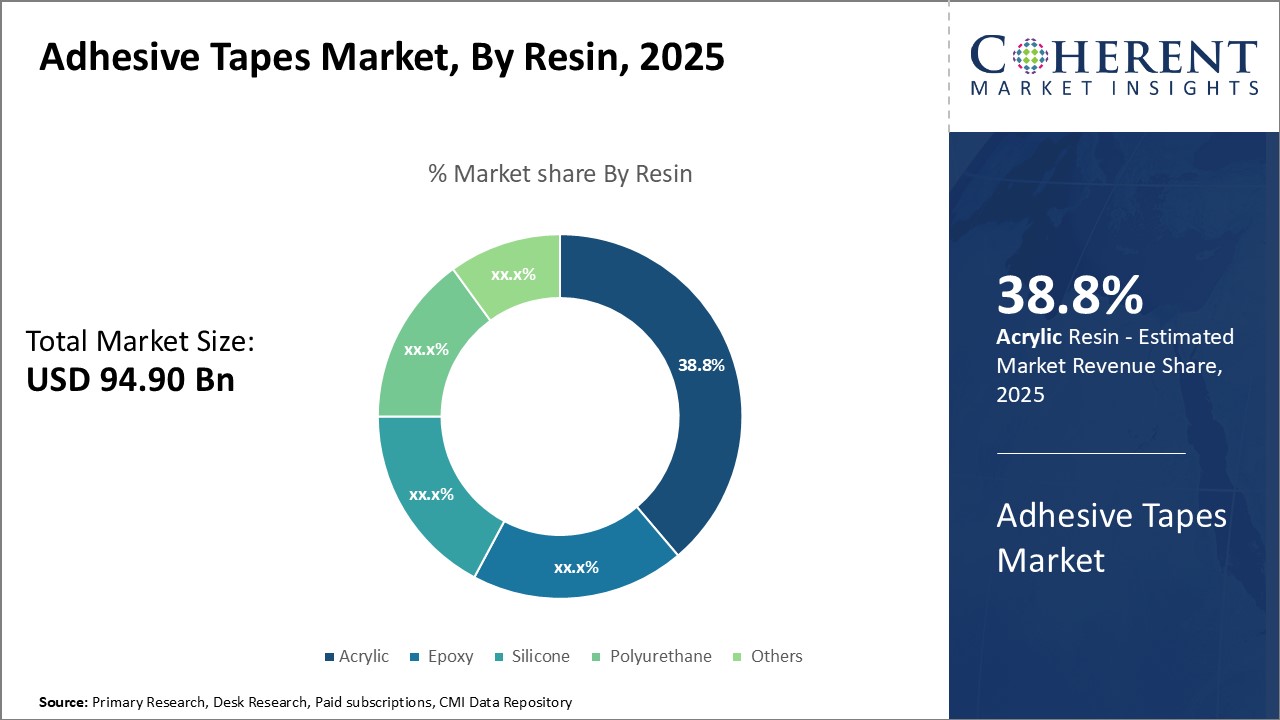
Discover high revenue pocket segments and roadmap to it: Request sample copy
Insights, By Resin - Adhesive Properties Drive the Acrylic Segment ShareIn terms of resin, acrylic is expected to contribute 38.8% share of the global adhesive tapes market in 2025 owing to its excellent adhesive properties. Acrylic tapes offer strong bonding to a wide range of surfaces including paper, plastic, metal, and glass. They form durable bonds instantly upon application and continue adhering firmly over time. The robust adhesive power of acrylic allows tapes made from it to withstand vibration, moisture, and temperature fluctuations better than other resin options. This consistency in performance across challenging conditions makes acrylic tapes a top choice for applications in construction, automotive, durable goods, and shipping/packaging industries where bonds need to withstand rigors of use and environmental stresses. Acrylic tapes are also removable and repositionable to a degree without leaving residue, expanding their utility. Moreover, acrylic is transparent allowing tape colors and designs to shine through, opening up opportunities in visual identification markets. Environmental friendly properties of acrylic along with benefits like conformability to irregular surfaces further augment its popularity as a resin for tapes. Strong adhesion capabilities along with versatility thus provide acrylic tapes an edge over competition.
Insights, By Technology - Technological Innovations Spur Hot Melt Dominance
In terms of technology, hot melt is expected to contribute 39.2% share of the global adhesive tapes market in 2025. This is owing to new technological innovations enhancing hot melt capabilities. Advancements in hot melt resin formulations now allow tapes to deliver high initial tack, optimized bond strength, and resistance to challenging conditions like heat, cold, and moisture upon aging. Hot melt tapes have transitioned from traditional packaging uses to more sophisticated industrial and engineering applications. Precision coating machinery maximize hot melt utilization and minimize raw material waste. On-line application systems ensure hot melt tapes can be used efficiently in automated production lines. Self-wounding designs with matrix release technology have also expanded hot melt tape applicability. Moreover, energy-efficient methods developed to cure hot melt adhesives reduce manufacturing costs. Technological evolutions thus keep improving various performance attributes of hot melt tapes. This drives their increased preference over solvent and water-based options across diverse sectors.
Insights, By End User Industry - Growing Automotive Industry Stimulates Demand
In terms of end user industry, automotive contributes 37.3% share of the global adhesive tapes market in 2025 attributed to robust growth of the automotive industry. Rising vehicle production worldwide along with advancements in automotive design and engineering are major demand catalysts. Adhesive tapes play an integral role in automotive manufacturing by aiding process efficiency. They are used for tasks like vehicle component assembly/fabrication, bonding of metals/composites, protective masking, and identification labeling. Specialized heat, moisture, and chemical resistant automotive grade adhesive tapes ensure firm and reliable bonds under harsh operational environments inside vehicle engines and exterior panels. Adhesive tapes also help automakers shave assembly time and labor costs. Their expendability compared to mechanical fasteners simplifies disassembly for part replacements. With new technologies making cars lighter, more sustainable, and autonomous, the applications of adhesive tapes in the automotive sector will further expand in the future. Therefore, the flourishing automotive industry acts as a key stimulant for adhesive tapes demand within its vast value chain.
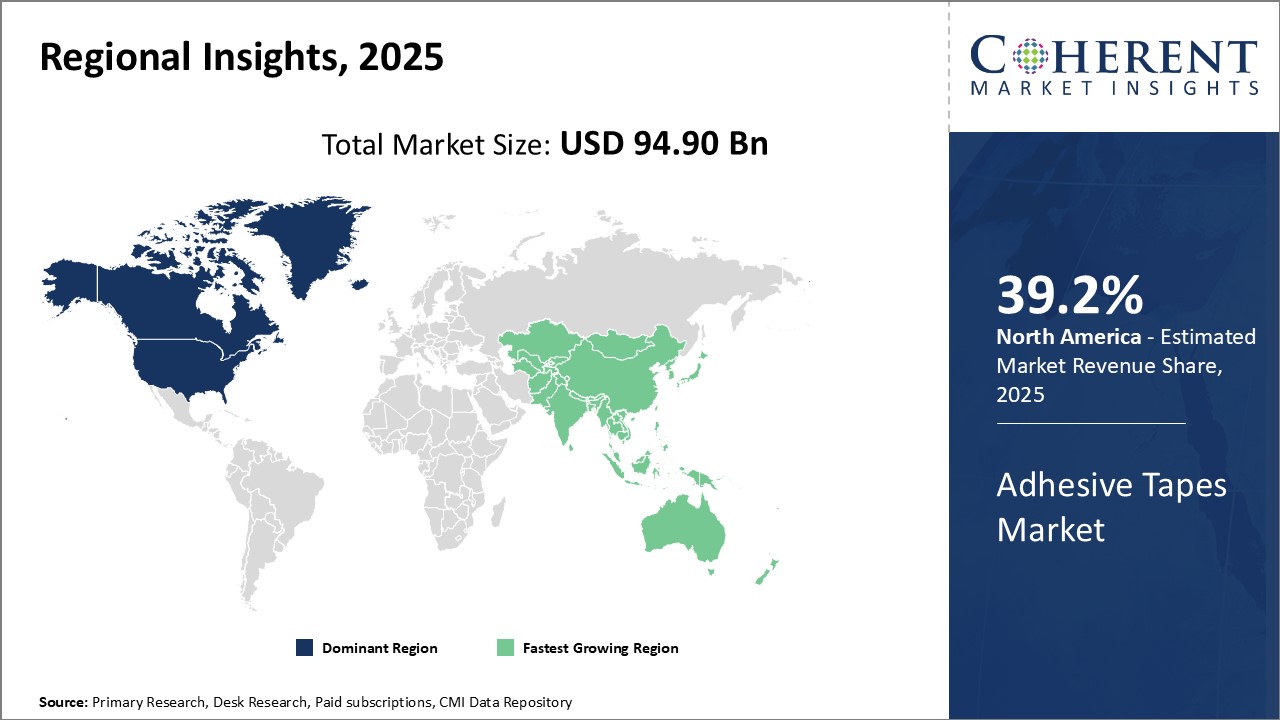
Need a Different Region or Segment? Customize now
North America has dominated the global adhesive tapes market for many years, owing to a strong presence of key industry players and high demand from end-use industries with 39.2% of the market share in 2025. The U.S. accounts for majority of the regional market share due to large automotive, healthcare, and packaging sectors. Leading manufacturers like 3M, tesa Tapes, and Berry Global have their headquarters in the U.S., giving them early-mover advantage to cater to indigenous demand as well as exports. Apart from strong manufacturing base, other factors spurring growth include high rate of infrastructure projects, retrofitting activities of buildings and robust consumer demand for home improvement and DIY activities. Growth in e-commerce has also bolstered the demand for carton sealing and other packaging tapes from logistics companies. Regional players are launching new product ranges targeting niche applications in electronics, graphics, and automotive Original Equipment Manufacturers (OEMs) to maintain their stronghold.
On the other hand, the Asia Pacific region has emerged as the fastest growing market for adhesive tapes globally over the past decade. China dominates the regional market owing to large manufacturing sector catering to both domestic as well as exports demand. Flourishing end-use industries like electronics, automotive, and appliances are driving volumes. Besides China, other Asian countries like India, Indonesia, Vietnam, and Philippines are witnessing double digit growth rates as manufacturing shifts from China. Ease of raw material availability and relatively cheaper labor costs are attracting leading global players to set up manufacturing bases in the region through joint ventures with local partners. Domestic players are also strengthening their distributor networks and product portfolios targeted at price-sensitive segments. Growth in infrastructure spending and building construction activities are further supplementing demand. With continued industrialization and urbanization trends, the Asia Pacific adhesive tapes market is projected to surpass other regions in the coming years.
Adhesive Tapes Market Report Coverage
| Report Coverage | Details | ||
|---|---|---|---|
| Base Year: | 2024 | Market Size in 2025: | USD 94.90 Bn |
| Historical Data for: | 2020 To 2024 | Forecast Period: | 2025 To 2032 |
| Forecast Period 2025 to 2032 CAGR: | 5.9% | 2032 Value Projection: | USD 141.84 Bn |
| Geographies covered: |
|
||
| Segments covered: |
|
||
| Companies covered: |
3M, Avery Dennison Corporation, DuPont, HB Fuller Company, Henkel AG & Co, KGaA, Intertape Polymer Group, Lintec Corporation, Nitto Denko Corporation, OJI, Holding Corporation, Scapa Group Plc, Sekisui Chemical Co. Ltd, Shurtape Technologies LLC, Sika AG, TESA SE, L&L Products, Inc., Adchem Corporation, Avery Dennison Corporation, and Saint Gobain |
||
| Growth Drivers: |
|
||
| Restraints & Challenges: |
|
||
Uncover macros and micros vetted on 75+ parameters: Get instant access to report
*Definition: The global adhesive tapes market includes various types of tapes that are used for binding, sticking, and supporting purposes. These pressure-sensitive tapes are made up of a backing and coating of adhesive. They are used across various industries like packaging, healthcare, electrical & electronics, white goods, automotive, and others. Some common types of adhesive tapes include single-coated tapes, double-coated tapes, reinforced tapes, and specialty tapes. The global market covers production, distribution, and sales of these tapes worldwide.
Share
Share
About Author
Pankaj Poddar is a seasoned market research consultant with over 12 years of extensive experience in the fast-moving consumer goods (FMCG) and plastics material industries. He holds a Master’s degree in Business Administration with specialization in Marketing from Nirma University, one of India’s reputed institutions, which has equipped him with a solid foundation in strategic marketing and consumer behavior.
As a Senior Consultant at CMI for the past three years, he has been instrumental in harnessing his comprehensive understanding of market dynamics to provide our clients with actionable insights and strategic guidance. Throughout his career, He has developed a robust expertise in several key areas, including market estimation, competitive analysis, and the identification of emerging industry trends. His approach is grounded in a commitment to understanding client needs thoroughly and fostering collaborative relationships. His dedication to excellence and innovation solidifies his role as a trusted advisor in the ever-evolving landscape of not only FMCG but also chemicals and materials markets.
Missing comfort of reading report in your local language? Find your preferred language :
Transform your Strategy with Exclusive Trending Reports :
Frequently Asked Questions
Joining thousands of companies around the world committed to making the Excellent Business Solutions.
View All Our Clients
US Reciprocal Tax Impact Analysis On Adhesive Tapes Market
Stay updated on tariff changes with expert insights and timely information